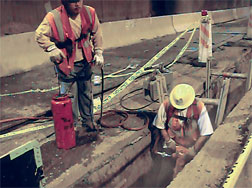Soaring fuel prices are crippling the aviation industry and airlines are cutting back on their infrastructure plans. But plenty of construction is still taking off at the airport serving one of America’s literally hottest regions.
 Aileen Cho /ENR Airport traffic requires night work.
|
Phoenix Sky Harbor Airport had planned a $2.9-billion expansion over five years, but has stretched that out to 2020, says David Hensley, deputy aviation director for design and construction. This year, there are two major expansion projects: a $580-million, 2-mile on-airport people mover system that will connect to the area’s light rail line, and a security checkpoint expansion for “C” gates at Terminal 4.
Most of the work for that $27-million, 19-month expansion is being done at night due to the nature of airport operations. “At an airport like Sky Harbor with a small footprint, it’s better to build at night anyway,” says Hensley. “During the summer, the night-shift people enjoy it.”
|
It was still well in the 90s at midnight one night this July as crews with Austin Commercial LP, the construction manager-at-risk, began drilling what will be eight sets of micropiles for 11 new columns and excavating 300 ft of new duct banks on a road that, during the day, is as busy as a highway. “We’re building a bridge under a parking structure and in a ‘city,’”says Steve Jensen, Austin project manager. Two lanes must be kept open.
 Aileen Cho /ENR Excavation done in wee hours.
|
The expansion from four to eight screening gates at Checkpoint C is the fourth handled by Austin, part of $47 million worth of work. It is similar to a previous expansion of another checkpoint. The enclosed bridge carrying the screening gates will increase from 60 ft wide to 180 ft wide. It will extend from the terminal, over the airport road and beneath a parking garage. Work must be done in shifts from midnight to 5 a.m.
The C bridge will consist of four 75-ft-long steel girders placed by a 550-ton crane with 37-ft clearance, working from in front of the garage, says Jensen. The girders weigh 1,300 lb per linear ft. A 1,805-sq-ft concession area also will be built directly over a baggage handling facility in the terminal. The existing roof will be removed and replaced for the new concessions floor.
Austin also must add three foundations in anticipation of a future automated train station. They consist of 16 caissons and three columns that will rise to the floor of Checkpoint C.
 Related Links:
Related Links: 